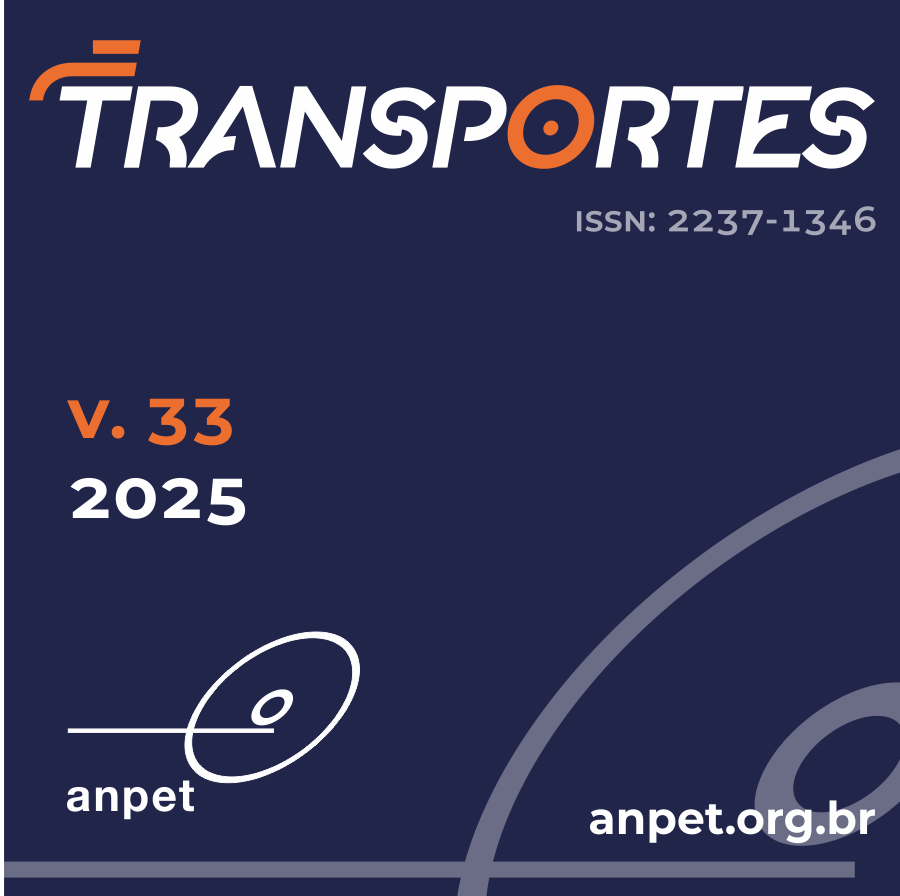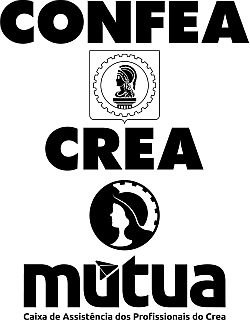Urban mobility scenarios: a review of the future
DOI:
https://doi.org/10.58922/transportes.v33.e3131Keywords:
Scenario Building, Sustainable Mobility, Mobility TrendsAbstract
This study analyzed urban mobility perspectives based on research found in the literature. The objective was to identify trends and actions prone to promote a more sustainable mobility future. To this end, 24 studies published between 2014 and 2025 were selected, resulting in 88 distinct scenarios. The studies indicate that technologies such as electric vehicles, autonomous vehicles, and shared mobility are promising but face economic and regulatory challenges. However, established solutions, such as promotion of public transportation and cycling, remain essential. The main trends observed were technological development, with autonomous vehicles and artificial intelligence; investments in public transportation and reducing the need for commuting; and environmental and social impacts, including inequality in mobility access and climate change. The study concluded that there are several major trends and strategic actions that are likely to shape the future of urban mobility.
Downloads
References
Álvarez-Antelo, D.; P. López-Muñoz; L. Llases et al. (2025) Towards a sustainable mobility lifestyle: exploring the flight to rail shift through model-based behavioural change scenarios. Ecological Economics, v. 230, p. 108498. DOI: 10.1016/j.ecolecon.2024.108498. DOI: https://doi.org/10.1016/j.ecolecon.2024.108498
Aulicino, A.L. (2002). Identificação de Problemas Potenciais na Construção de Cenários e na Formulação de Estratégias em uma Organização: Proposição de um Método: um Estudo de Caso. Thesis (master’s degree). University of São Paulo. São Paulo, SP. DOI: 10.11606/D.12.2002.tde-12092006-155128. DOI: https://doi.org/10.11606/D.12.2002.tde-12092006-155128
Baera, E.J.; L. Alfheim; G. Lyons et al. (2025) Using scenarios to address uncertainty in planning for sustainable mobility in small and medium-sized Norwegian cities. European Transport Research Review, v. 17, n. 1, p. 18. DOI: 10.1186/s12544-025-00710-3. DOI: https://doi.org/10.1186/s12544-025-00710-3
Banister, D.; R. Hickman and D. Stead (2007) Looking Over the Horizon: Visioning and Backcasting. In Perrels, A., V. Himanen and M. Lee-Gosselin (eds.) Building Blocks for Sustainable Transport: Obstacles, Trends, Solutions. England: Emerald Group Publishing Limited, p. 25–53. DOI: https://doi.org/10.1108/9780857245168-003
Barrella, E. and A.A. Amekudzi (2011) Backcasting for sustainable transportation planning. Transportation Research Record: Journal of the Transportation Research Board, v. 2242, n. 1, p. 29-36. DOI: 10.3141/2242-04. DOI: https://doi.org/10.3141/2242-04
Brenden, A.P.; I. Kristoffersson and L.-G. Mattsson (2017). Future Scenarios for Self-Driving Vehicles in Sweden. Stockholm: KTH Royal Institute of Technology.
Buarque, S.C. (2003) Metodologia e Técnicas de Construção de Cenários Globais e Regionais. Brasília: Ipea. Available at: <http://repositorio.ipea.gov.br/handle/11058/2865> (accessed 07/14/2025).
Canitez, F. (2019) Pathways to sustainable urban mobility in developing megacities: a socio-technical transition perspective. Technological Forecasting and Social Change, v. 141, p. 319-29. DOI: 10.1016/j.techfore.2019.01.008. DOI: https://doi.org/10.1016/j.techfore.2019.01.008
Cascetta, E. (2014) Future scenarios of urban mobility and their sustainability. E3S Web of Conferences, v. 2, p. 03002. DOI: 10.1051/e3sconf/20140203002. DOI: https://doi.org/10.1051/e3sconf/20140203002
Colin, L.; B. Cedric; C. Corinne et al. (2024) From narratives to indicator-based future scenarios of urban mobility. Futures, v. 162, p. 103431. DOI: 10.1016/j.futures.2024.103431. DOI: https://doi.org/10.1016/j.futures.2024.103431
Denney, A.S. and R. Tewksbury (2013) How to write a literature review. Journal of Criminal Justice Education, v. 24, n. 2, p. 218-34. DOI: 10.1080/10511253.2012.730617. DOI: https://doi.org/10.1080/10511253.2012.730617
Dia, H. (2019) Rethinking urban mobility: unlocking the benefits of vehicle electrification. In Newton, P.; D. Prasad; A. Sproul et al. (eds.) Decarbonising the Built Environment. Singapore: Springer Singapore, p. 83–98. DOI: 10.1007/978-981-13-7940-6_5. DOI: https://doi.org/10.1007/978-981-13-7940-6_5
Godet, M. (2006) Creating Futures: Scenario Planning as a Strategic Management Tool (2nd ed.). London: Economica.
Hickman, R. and D. Banister (2007) Transport and Reduced Energy Consumption: What Role Can Urban Planning Play? Oxford: University of Oxford.
Huss, W.R. and E.J. Honton (1987) Scenario planning - what style should you use? Long Range Planning, v. 20, n. 4, p. 21-29. DOI: 10.1016/0024-6301(87)90152-X. DOI: https://doi.org/10.1016/0024-6301(87)90152-X
Kane, M. and J. Whitehead (2017) How to ride transport disruption – a sustainable framework for future urban mobility. Australian Plants, v. 54, n. 3, p. 177-85. DOI: 10.1080/07293682.2018.1424002. DOI: https://doi.org/10.1080/07293682.2018.1424002
Kaufmann, V. and E. Ravalet (2016) From weak signals to mobility scenarios: a prospective study of France in 2050. Transportation Research Procedia, v. 19, p. 18-32. DOI: 10.1016/j.trpro.2016.12.064. DOI: https://doi.org/10.1016/j.trpro.2016.12.064
Keseru, I.; T. Coosemans and C. Macharis (2019) Building scenarios for the future of transport in Europe: the Mobility4EU approach. In Müller, B. and G. Meyer (eds.) Towards User-Centric Transport in Europe. Cham: Springer, p. 15–30. DOI: 10.1007/978-3-319-99756-8_2. DOI: https://doi.org/10.1007/978-3-319-99756-8_2
Lyons, G.; C. Rohr, A. Smith et al. (2021) Scenario planning for transport practitioners. Transportation Research Interdisciplinary Perspectives, v. 11, p. 100438. DOI: 10.1016/j.trip.2021.100438. DOI: https://doi.org/10.1016/j.trip.2021.100438
Mara Dorigati, T. and C. Krupp Luz (2020) Três cenários para a relação entre trabalho e gênero frente à quarta revolução industrial. Revista da Faculdade de Direito da Universidade Federal de Uberlândia, v. 47, n. 2. DOI: 10.14393/RFADIR-v47n2a2019-49063. DOI: https://doi.org/10.14393/RFADIR-v47n2a2019-49063
Marletto, G. (2014) Car and the city: socio-technical transition pathways to 2030. Technological Forecasting and Social Change, v. 87, p. 164-78. DOI: 10.1016/j.techfore.2013.12.013. DOI: https://doi.org/10.1016/j.techfore.2013.12.013
Meerow, S. and J.P. Newell (2019) Urban resilience for whom, what, when, where, and why. Urban Geography, v. 40, n. 3, p. 309-29. DOI: 10.1080/02723638.2016.1206395. DOI: https://doi.org/10.1080/02723638.2016.1206395
Melkonyan, A.; T. Gruchmann; F. Lohmar et al. (2022) Decision support for sustainable urban mobility: a case study of the Rhine-Ruhr area. Sustainable Cities and Society, v. 80, p. 103806. DOI: 10.1016/j.scs.2022.103806. DOI: https://doi.org/10.1016/j.scs.2022.103806
Melkonyan, A.; J. Koch; F. Lohmar et al. (2020) Integrated urban mobility policies in metropolitan areas: A system dynamics approach for the Rhine-Ruhr metropolitan region in Germany. Sustainable Cities and Society, v. 61, p. 102358. http://doi.org/10.1016/j.scs.2020.102358. DOI: https://doi.org/10.1016/j.scs.2020.102358
Milakis, D.; M. Snelder; B. Van Arem et al. (2017) Development and transport implications of automated vehicles in the Netherlands: scenarios for 2030 and 2050. European Journal of Transport and Infrastructure Research. DOI: 10.18757/EJTIR.2017.17.1.3180. DOI: https://doi.org/10.18757/EJTIR.2017.17.1.3180
Miskolczi, M.; D. Földes; A. Munkácsy et al. (2021) Urban mobility scenarios until the 2030s. Sustainable Cities and Society, v. 72, p. 103029. DOI: 10.1016/j.scs.2021.103029. DOI: https://doi.org/10.1016/j.scs.2021.103029
Navarro-Ligero, M.L. and L.M. Valenzuela-Montes (2016) A tool for the assessment of urban mobility scenarios in climate change mitigation: an application to the Granada’s LRT Project. Transportation Research Procedia, v. 19, p. 364-79. DOI: 10.1016/j.trpro.2016.12.095. DOI: https://doi.org/10.1016/j.trpro.2016.12.095
Nijkamp, P. and K. Kourtit (2013) The “New Urban Europe”: global challenges and local responses in the urban century. European Planning Studies, v. 21, n. 3, p. 291-315. DOI: 10.1080/09654313.2012.716243. DOI: https://doi.org/10.1080/09654313.2012.716243
Nikitas, A.; I. Kougias; E. Alyavina et al. (2017) How can autonomous and connected vehicles, electromobility, BRT, hyperloop, shared use mobility and mobility-as-a-service shape transport futures for the context of smart cities. Urban Science, v. 1, n. 4, p. 36. DOI: 10.3390/urbansci1040036. DOI: https://doi.org/10.3390/urbansci1040036
WHO (2021) Plano Global Década de Ação pela Segurança no Trânsito. Geneva: World Health Organization. Available at: <http://who.int/pt/publications/m/item/global-plan-for-the-decade-of-action-for-road-safety-2021-2030> (accessed 10/8/2025).
Paul, A.; U. Schmalz; A. Cook et al. (2023) Future multimodal mobility scenarios within Europe. Transportation Research Procedia, v. 72, p. 1869-76. DOI: 10.1016/j.trpro.2023.11.665. DOI: https://doi.org/10.1016/j.trpro.2023.11.665
Porter, M.E. (1989) Competitive Advantage. New York: Free Press.
Ringland, G. (2006) Scenario Planning: Managing for the Future (2nd ed.). Chichester: John Wiley & Sons Ltd.
Rojas-Rivero, A.; M. Navarro-Ligero; M.E. López-Lambas et al. (2025) Archetypes of collaboration within urban transport system scenarios. Futures, v. 171, p. 103628. DOI: 10.1016/j.futures.2025.103628. DOI: https://doi.org/10.1016/j.futures.2025.103628
Spickermann, A.; V. Grienitz and H.A. Von Der Gracht (2014) Heading towards a multimodal city of the future: Multi-stakeholder scenarios for urban mobility. Technological Forecasting and Social Change, v. 89, p. 201-21. DOI: 10.1016/j.techfore.2013.08.036. DOI: https://doi.org/10.1016/j.techfore.2013.08.036
Störmer, E.; B. Truffer; D. Dominguez et al. (2009) The exploratory analysis of trade-offs in strategic planning: lessons from regional infrastructure foresight. Technological Forecasting and Social Change, v. 76, n. 9, p. 1150-62. DOI: 10.1016/j.techfore.2009.07.008. DOI: https://doi.org/10.1016/j.techfore.2009.07.008
Sunitiyoso, Y.; A. Wicaksono; N.F. Pambudi et al. (2023) Future of mobility in Jakarta metropolitan area: a multi-stakeholder scenario planning. Transportation Research Interdisciplinary Perspectives, v. 19, p. 100810. DOI: 10.1016/j.trip.2023.100810. DOI: https://doi.org/10.1016/j.trip.2023.100810
Tori, S.; G. Te Boveldt and I. Keseru (2023) Building scenarios for urban mobility in 2030: The combination of cross-impact balance analysis with participatory stakeholder workshops. Futures, v. 150, p. 103160. DOI: 10.1016/j.futures.2023.103160. DOI: https://doi.org/10.1016/j.futures.2023.103160
Tori, S.; G. Te Boveldt; I. Keseru et al. (2023) Brussels mobility in 2050: Participatory mixed-method scenario building to explore alternative futures. Transp Res Interdiscip Perspect, v. 22, p. 100919. DOI: 10.1016/j.trip.2023.100919. DOI: https://doi.org/10.1016/j.trip.2023.100919
TomTom (2025) TomTom Traffic Index: When Cities Move, our World Moves Forward. Available at: <https://www.tomtom.com/en_gb/traffic-index/> (accessed 7/7/2025).
Turner, N. (2008) Future-proofing your organisation. CEO Journal, v. 1. Available at: https://www.researchgate.net/publication/292707260_Future-proofing_your_organisation (accessed 10/8/2025).
Vallet, F.; J. Puchinger; A. Millonig et al. (2020) Tangible futures: combining scenario thinking and personas - A pilot study on urban mobility. Futures, v. 117, p. 102513. DOI: 10.1016/j.futures.2020.102513. DOI: https://doi.org/10.1016/j.futures.2020.102513
Van Der Heijden, K. (2000) Scenarios and forecasting. Technological Forecasting and Social Change, v. 65, n. 1, p. 31-6. DOI: 10.1016/S0040-1625(99)00121-3. DOI: https://doi.org/10.1016/S0040-1625(99)00121-3
Xenou, E.; G. Ayfantopoulou; B. Royo et al. (2022) Methodology for consequence analysis of future mobility scenarios: the SPROUT framework. Future Transportation, v. 2, n. 2, p. 453-66. DOI: 10.3390/futuretransp2020025. DOI: https://doi.org/10.3390/futuretransp2020025
Yanmaz, O. and U. Asan (2024) A novel scenario planning approach considering criteria interaction in multi-criteria evaluation: an application to urban mobility. Decision Science Letters, v. 13, n. 2, p. 461-70. DOI: 10.5267/j.dsl.2024.1.002. DOI: https://doi.org/10.5267/j.dsl.2024.1.002
Zahraei, S.M.; J.H. Kurniawan and L. Cheah (2019) A foresight study on urban mobility: Singapore in 2040. Foresight, v. 22, n. 1, p. 37-52. DOI: 10.1108/FS-05-2019-0044. DOI: https://doi.org/10.1108/FS-05-2019-0044
Zmud, J.; L. Ecola; P. Phleps et al. (2013) The Future of Mobility: Scenarios for the United States in 2030. Santa Monica: Rand Corporation. Available at: <https://www.rand.org/content/dam/rand/pubs/research_reports/RR200/RR246/RAND_RR246.pdf> (accessed 10/8/2025).
Downloads
Published
How to Cite
Issue
Section
License
Copyright (c) 2025 Amanda Christine Gallucci Silva, Luciano Wons, Tatiana Maria Cecy Gadda

This work is licensed under a Creative Commons Attribution 4.0 International License.
Authors who submit papers for publication by TRANSPORTES agree to the following terms:
- The authors retain the copyright and grant Transportes the right of first publication of the manuscript, without any financial charge, and waive any other remuneration for its publication by ANPET.
- Upon publication by Transportes, the manuscript is automatically licensed under the Creative Commons License CC BY 4.0 license. This license permits the work to be shared with proper attribution to the authors and its original publication in this journal.
- Authors are authorized to enter into additional separate contracts for the non-exclusive distribution of the version of the manuscript published in this journal (e.g., publishing in an institutional repository or as a book chapter), with recognition of the initial publication in this journal, provided that such a contract does not imply an endorsement of the content of the manuscript or the new medium by ANPET.
- Authors are permitted and encouraged to publish and distribute their work online (e.g., in institutional repositories or on their personal websites) after the editorial process is complete. As Transportes provides open access to all published issues, authors are encouraged to use links to the DOI of their article in these cases.
- Authors confirm they have obtained all required employer permissions for the publication and CC BY 4.0 licensing of the manuscript, particularly if the employer holds any claim to the manuscript's copyright. Authors assume all responsibility for employer-related copyright issues, releasing ANPET and Transportes from any related liability.
- Authors assume full responsibility for the content of the manuscript, including the necessary and appropriate authorizations for the disclosure of collected data and obtained results, releasing ANPET and Transportes from any responsibility in this regard.
Last update: 11/27/2025











